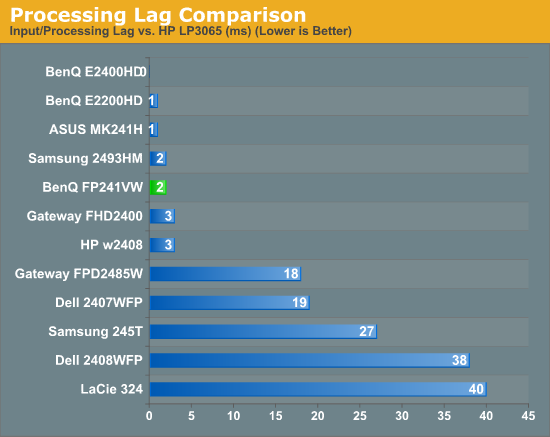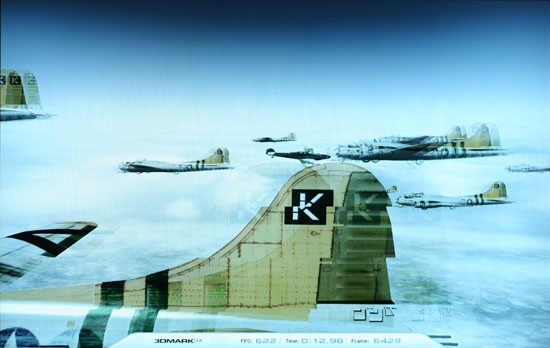Display Lag and Response Time
One of the areas where the A-MVA panel does extremely well is in the areas of display lag and pixel response time. Just to recap, you may have heard complaints about "input lag" on various LCDs, so that's one area we look at in our LCD reviews. We put input lag in quotation marks because while many people call it "input lag", the reality is that this lag occurs somewhere within the LCD panel circuitry, or perhaps even at the level of the liquid crystals. Where this lag occurs isn't the concern; instead, we just want to measure the duration of the lag. That's why we prefer to call it "processing lag" or "display lag".
To test for display lag, we run the Wings of Fury benchmark in 3DMark03, with the output set to the native LCD resolution - in this case 1920x1200. Our test system is a quad-core Q6600 running a Radeon HD 3870 on a Gigabyte GA-X38-DQ6 motherboard - we had to disable CrossFire support in order to output the content to both displays. We connect the test LCD and a reference LCD to two outputs from the Radeon 3870 and set the monitors to run in clone mode.
The reference Monitor is an HP LP3065, which we have found to be one of the best LCDs we currently possess in terms of not having display lag. (The lack of a built-in scaler probably has something to do with this.) While we know some of you would like us to compare performance to a CRT, that's not something we have around our offices anymore. Instead, we are looking at relative performance, and it's possible that the HP LP3065 has 20ms of lag compared to a good CRT - or maybe not. Either way, the relative lag is constant, so even if a CRT is faster at updating, we can at least see if an LCD is equal to or better than our reference display.
While the benchmark is looping, we snap a bunch of pictures of the two LCDs sitting side-by-side (using a relatively fast shutter speed). 3DMark03 shows the runtime with a resolution of 10ms at the bottom of the display, and we can use this to estimate whether a particular LCD has more or less processing lag than our reference LCD. We sort through the images and discard any where the times shown on the LCDs are not clearly legible, until we are left with 10 images for each test LCD. We record the difference in time relative to the HP LP3065 and average the 10 results to come up with an estimated processing lag value, with lower numbers being better. Negative numbers indicate a display is faster than the HP LP3065, while positive numbers mean the HP is faster and has less lag.
It's important to note that this is merely an estimate - whatever the reference monitor happens to be, there are some inherent limitations. For one, LCDs only refresh their display 60 times per second, so we cannot specifically measure anything less than approximately 17ms with 100% accuracy. Second, the two LCDs can have mismatched vertical synchronizations, so it's entirely possible to end up with a one frame difference on the time readout because of this. That's why we average the results of 10 images, and we are confident that our test procedure can at least show when there is a consistent lag/internal processing delay. Here is a summary of our results for the displays we have tested so far.
 |
| Display Input/Processing Lag vs. HP LP3065 | |||||||||||
| One | Two | Three | Four | Five | Six | Seven | Eight | Nine | Ten | Avg. (ms) | |
| ASUS MK241H | 10 | 0 | 0 | 0 | 0 | 0 | 0 | 0 | 0 | 0 | 1 |
| BenQ E2200HD | 0 | 0 | 0 | 10 | 0 | 0 | 0 | 0 | 0 | 0 | 1 |
| BenQ E2400HD | 0 | 0 | 0 | 10 | -10 | 0 | -10 | 0 | 0 | 10 | 0 |
| BenQ FP241VW | 0 | -10 | 0 | 10 | 0 | 10 | 0 | 0 | 10 | 0 | 2 |
| Dell 2407WFP | 10 | 20 | 30 | 20 | 10 | 10 | 30 | 30 | 10 | 20 | 19 |
| Dell 2408WFP | 30 | 40 | 40 | 40 | 30 | 30 | 40 | 30 | 50 | 50 | 38 |
| Gateway FHD2400 | -10 | -10 | 0 | 10 | 10 | 10 | 0 | 10 | 10 | 0 | 3 |
| Gateway FPD2485W | 30 | 10 | 20 | 20 | 20 | 10 | 0 | 30 | 20 | 20 | 18 |
| HP w2408 | 10 | 10 | 0 | 0 | 0 | 0 | 0 | 10 | 0 | 0 | 3 |
| LaCie 324 | 40 | 30 | 40 | 30 | 40 | 50 | 40 | 50 | 50 | 30 | 40 |
| Samsung 245T | 30 | 30 | 30 | 30 | 30 | 20 | 30 | 30 | 20 | 20 | 27 |
| Samsung 2493HM | 0 | 10 | 0 | 0 | 0 | 10 | 0 | -10 | 0 | 10 | 2 |

As you can see, all of the S-PVA panels we have tested to date show a significant amount of input lag, ranging from 20ms up to 40ms. In contrast, the TN and S-IPS panels show little to no processing lag (relative to the HP LP3065). The BenQ FP241VW performs similarly to the TN and IPS panels, with an average display lag of 2ms - not something you would actually notice compared to other LCDs. Obviously, if you're concerned with display lag at all, you'll want to avoid S-PVA panels for the time being. That's unfortunate, considering S-PVA panels perform very well in other areas.
 |
Despite what the manufacturers might advertise as their average pixel response time, we found most of the LCDs are basically equal in this area - they all show roughly a one frame "lag", which equates to a response time of around 16ms. In our experience, processing lag is far more of a concern than pixel response times. Taking a closer look at just the FP241VW, we can see the typical one frame lag in terms of pixel response time. However, the panel does appear to be a little faster in response time than some of the other panels we've tested (notice how the "ghost image" isn't as visible as on the HP LP3065), and we didn't see parts of three frames in any of the test images.
Update: What Causes Display Lag?
After the initial article went live, one of our readers who works in the display industry sent me an email. He provides some interesting information about the causes of image lag. Below is an (edited) excerpt from his email. (He wished to remain anonymous.)
PVA and MVA have inherent drawbacks with respect to LCD response time, especially gray-to-gray. To address this shortcoming, companies have invested in ASICs that perform a trick generically referred to as "overshoot." The liquid crystal (LC) material in *VA responds sluggishly to small voltage changes (a change from one gray level to another). To fix this, the ASIC does some image processing and basically applies an overvoltage to the electrodes of the affected pixel to spur the LC material into rapid movement. Eventually the correct settling voltage is applied to hold the pixel at the required level matching the input drive level.
It's very complicated math taking place in the ASIC in real time. It works well but with an important caveat: it requires a frame buffer. What this means is that as video comes into the panel, there is a memory device that can capture one whole video frame and hold it. After comparing it to the next incoming frame, the required overshoot calculations are made. Only then is the first captured frame released to the panel's timing controller, which is when the frame is rendered to the screen. As you may have already guessed, that causes at least one frame time worth of lag (17ms).
Some companies discovered some unintended artifacts in their overshoot calculations and the only way they saw to correct these was to allow for their algorithm to look ahead by two frames instead of one. So they had to up the memory of the frame buffer and now they started capturing and holding not one but two frames upon which they make their complex overshoot predictions to apply the corrected pixel drive levels and reduce gray-to-gray response time (at the expense of lag time). Again, it works very well for improving response time, but at the expense of causing lag, which gamers hate. That in a nutshell is the basis of around 33ms of the lag measured with S-PVA.
[End Excerpt - the following is not from our reader]
Not every display uses this approach, but this could account for the increase in display lag between earlier S-PVA and later S-PVA panels. It's also important to note that I tested the Dell 2408WFP revision A00, and apparently revision A01 does not have as much lag. I have not been able to confirm this personally, however. The above also suggest that displays designed to provide a higher image quality through various signal processing techniques could end up with more display lag caused by the microchip and microcode, which makes sense. Now all we need are better algorithms and technologies in order to reduce the need for all of this extra image processing -- or as we have seen with some displays (particularly HDTVs), the ability to disable the image processing.










114 Comments
View All Comments
TA152H - Saturday, June 20, 2009 - link
Even back 20 years ago, only a certain amount of companies made shadow masks too. Nanao did not make their own, but, yet, their screens were the best. It's not as simple as you make it sound.It's actually possible that NEC might make a better monitor in some instance, although I've never seen it, but, by and large, Eizo is much better. You know when you're looking at an Eizo.
The picture quality is much better than NEC, or anyone else. I'll say this though, I have had uneven reliability with Eizo. Some monitors have been fine, and but more than there should be died quickly or had intermittent problems they should not have. This happens with all monitors, of course, but, in my small sample set, Eizo monitors have had more problems than others, but a small degree.
Clearly, all that money is put into picture quality, not reliability.
darklight0tr - Wednesday, June 17, 2009 - link
Expensive != Quality and Eizo is proof of this.Our internal graphics department recently moved to 24" Eizo monitors at $1700 a pop and HATE them. They are inconsistent across the display, and are no better than the standard DELLs we use for the rest of the environment. They had high expectations for those displays and were really let down and the Eizo rep was no help at all. Its funny how communication diminished as soon as the sale was completed.
What a waste of money.
TA152H - Saturday, June 20, 2009 - link
It's funny, because two people where I work got two Eizo's, and everyone wants them, and comments on them.Even on independent reviews, when they actually do get reviewed, they always are rated extremely highly, except for price. I don't know why your experience would be so much different, but, it sounds like you guys are either stupid (for not looking at the monitors first before buying a bunch), or it's made up.
Probably the latter, since no one would buy a monitor that was really expensive without seeing it and judging it first.
darklight0tr - Monday, June 22, 2009 - link
Wow, a whole two people. What a great example you have there.We have a whole department with them (almost 20 monitors) and while they work okay, most of them don't live up to the price tag. As I said, the colors aren't consistent across the display, even after calibration (yeah, us stupid people actually know how to do that). This happens with pretty much every one we have. We didn't buy them sight unseen either, which would have been pretty moronic. I think it is the backlight that causes many of the issues, which is unfortunate. I hope LED backlight displays help with this problem.
Who cares if they are reviewed well? I have them here in person and they don't live up to the price OR the reviews.
Calling me stupid, how mature. How about not judging me based on your own limited experience?
JarredWalton - Wednesday, June 17, 2009 - link
See, that's the problem: server CPUs start out as super fast but the tech makes its way to consumer products. The same thing has happened with GPUs, HDDs, RAM, etc. to varying degrees - it's all substantially cheaper now and performance has improved. But LCDs? Well, Eizo makes high quality LCDs, certainly, but they cost an arm and a leg. The cheapest 24" Eizo (taking a quick look) is over $800, with other models costing $1500 or more. They may be the best displays on the market, but what I want is to see that quality make its way into $500 LCDs.Spoelie - Wednesday, June 17, 2009 - link
http://translate.google.com/translate?prev=hp&...">http://translate.google.com/translate?p...mp;sl=nl...Launched in japan just yesterday with a $500 pricetag...
Now if only they would sell it abroad as well with a similar pricetag. And we need a review, it's "VA" technology but which one?
Mastakilla - Wednesday, June 17, 2009 - link
Eizo is not at all that good for it's priceFor a similar price you get a muuuuuuch better NEC monitor (check out the xx90 series)
Griswold - Wednesday, June 17, 2009 - link
Not going to happen. Well, maybe eventually the cheapos arrive at todays quality of Eizo, but then Eizo would have moved beyond that again. :PQuality and spending a few hundred bucks just doesnt go together. Buy Eizo and be happy for many, many years - not only due to the 5 years on-site warranty (not that I've ever had to make use of it, though..)
HexiumVII - Wednesday, June 17, 2009 - link
I've been using of those old Soyo 24" with the MVA I got for $250 a few years back, its great, has all the advantages of MVA and color is very accurate with my spyder. At school we have 24" iMacs and the screen is just friggin amazing. It's just so much better than everything else out there. A lot of it has to do with the glossy screen. So here's to a 24" 16:10 screen with gloss for a reasonable price one day.marraco - Wednesday, June 17, 2009 - link
I got crazy trying to play Crisys 2 at the morning on a glossy monitor. There was no way to see clearly the image without reflections. There was no way to accommodate the monitor to reduce reflex.glossy is an absolute crap. I hate it from gut.